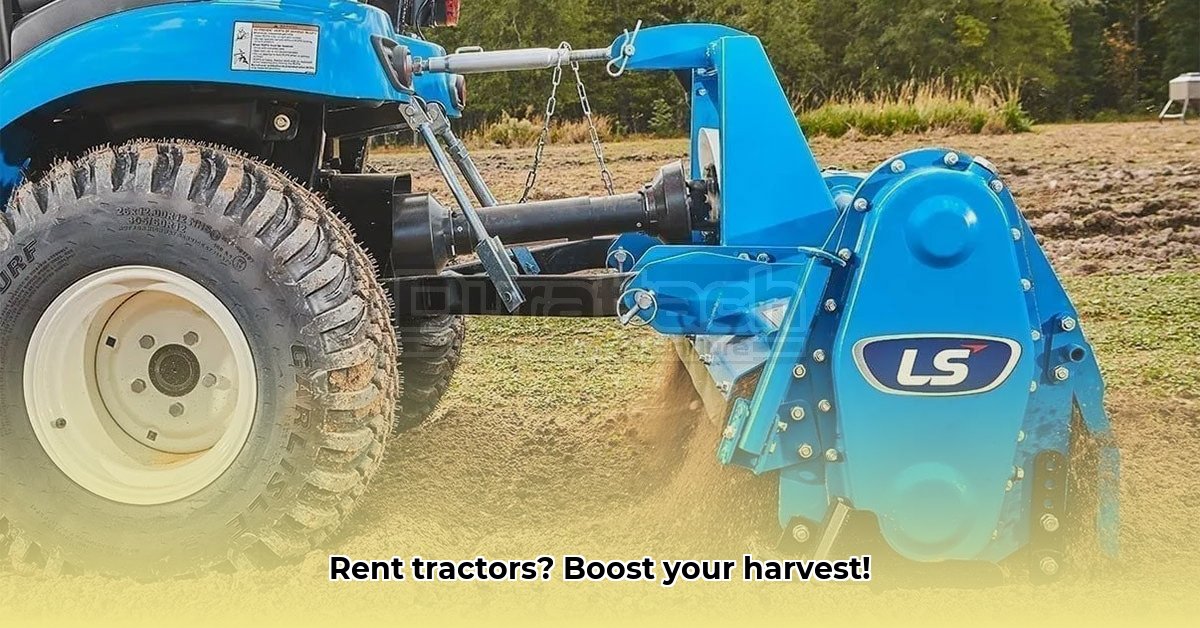
Tractor Implement Rental: A Growing Trend in Sustainable Agriculture
Farming demands efficiency and access to specialized tools. While purchasing equipment is a significant investment, renting tractors and implements offers a cost-effective and flexible alternative, particularly beneficial for smaller farms or those with seasonal needs. This guide explores the advantages, challenges, and future of tractor implement rentals, providing actionable steps for farmers, rental companies, and policymakers. For more quick connects, check out this helpful resource: Quick Connect Guide.
The Rise of Tractor Implement Rentals: Flexibility and Affordability
The increasing popularity of tractor implement rentals reflects a shift toward greater operational flexibility and reduced financial burdens. Farmers can access a diverse range of equipment—from small tractors for smaller plots to large-scale machinery—tailored to specific tasks and seasonal demands. This avoids the substantial upfront investment associated with purchasing equipment outright. "Renting allows farmers to access the specific equipment they need for the duration of the task, without the long-term financial commitment of ownership," explains Dr. Anya Sharma, Agricultural Economist at the University of California, Davis. This flexibility is particularly valuable for managing fluctuating workloads and adapting to changing market conditions.
Navigating the World of Tractor Implement Rentals: Finding the Right Fit
The market for rented farm equipment is diverse, offering tractors and a wide array of implements like tillers, planters, and sprayers. However, finding the right equipment at the right price necessitates careful planning. Not all rental companies provide the same level of service or transparency. "Lack of clear pricing and availability information remains a significant challenge," notes John Miller, CEO of AgriRentals, a leading farm equipment rental company. This lack of transparency highlights the need for improved online resources and platforms offering standardized information and comparison tools.
Challenges and Opportunities: Transparency and Technological Advancements
A major hurdle in the rental market is the lack of transparency regarding pricing and equipment availability. This hinders informed decision-making for farmers. However, technology offers a path to improved transparency. Online platforms are emerging which provide real-time availability updates, streamlined booking, and price comparisons across different providers. This enhanced transparency empowers farmers to make more informed choices and optimize their operations. The integration of precision agriculture technologies, such as GPS guidance and sensor-based monitoring, further enhances efficiency and sustainability.
Actionable Steps for Stakeholders: Optimizing the Rental Process
This section provides a structured guide for effective engagement within the tractor implement rental ecosystem.
Actionable Steps for Farmers: Maximizing Rental Efficiency
- Assess Needs: Determine the size of the operation, crop types, and specific tasks requiring specialized equipment. Consider soil conditions and acreage.
- Research and Compare: Investigate local rental companies and online platforms, comparing pricing, equipment condition (check reviews!), and included services (maintenance, insurance).
- Negotiate the Agreement: Clarify rental duration, cost, additional fees (insurance, delivery), and maintenance responsibilities. Thoroughly read the contract.
- Insurance and Maintenance: Ensure adequate insurance coverage protects against accidents or damage. Understand who is responsible for maintenance during the rental period.
- Pre- and Post-Rental Inspection: Conduct a thorough inspection before and after rental, documenting the equipment's condition (photos/videos) to avoid disputes.
Actionable Steps for Rental Companies: Enhancing Service and Transparency
- Improve Online Presence: Develop user-friendly websites with clear pricing, availability, and equipment specifications.
- Streamline Booking: Offer online booking systems with real-time inventory updates.
- Enhance Transparency: Clearly outline all fees, policies, and insurance options.
- Invest in Technology: Integrate GPS tracking and maintenance scheduling systems to improve efficiency and customer service.
- Gather Customer Feedback: Regularly solicit and respond to customer reviews to improve services.
Actionable Steps for Government and Policy Makers: Fostering Market Growth
- Support Technology Adoption: Provide subsidies or grants to encourage adoption of precision agriculture technologies and online rental platforms.
- Promote Transparency: Establish industry standards for pricing and information disclosure.
- Invest in Infrastructure: Improve rural internet access to facilitate online bookings and data transfer.
- Education and Training: Offer educational programs for farmers on utilizing rental equipment and precision technologies.
- Standardize Rental Agreements: Develop model contracts to protect both renters and rental companies.
Technology's Impact: Precision Agriculture and Rental Equipment
Precision agriculture technologies significantly improve efficiency and sustainability. GPS guidance systems, sensor-based monitoring, and variable-rate application drastically reduce waste and optimize resource use. Renting equipment equipped with these technologies makes them accessible to even smaller farms, promoting sustainable farming practices. "The integration of technology transforms tractor rentals from simple equipment access to strategic partnerships driving efficiency gains," explains Mark Olsen, Director of Innovation at FarmTech Solutions.
The Future of Tractor Implement Rentals: Continued Growth and Innovation
The future of tractor implement rentals is bright. Technological advancements will further streamline the process, improving transparency and efficiency. The ongoing integration of precision agriculture technologies promises increased productivity, sustainability, and profitability for farmers. This trend will continue to gain momentum, enhancing the profitability and sustainability of agricultural operations worldwide.